

The British arrive in Tasmania - 5,9 (History) How to get ahead in Van Diemen's Land - 5,9 (History) Well, this little book is quite an interesting little primer document.
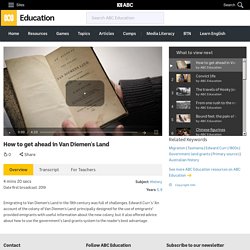
It's a rare book. It was published in 1824 by a man called George Cowie by George Cowie & Company. The interesting thing about George Cowie is that, after his death, his wife and son actually followed his advice and emigrated to Diemen's Land, which is Tasmania. So the book is called An Account of the Colony of Van Diemen's Land, Principally Designed for the Use of Immigrants. And it was by a man called Edward Curr. So he writes here-- "I would recommend none to emigrate. In other words, what he wants to do is show people how to screw the system, how to make best use of what they have. So Governor Arthur's system was really intended to set up a sort of pseudo feudal system. The system was designed to keep people in their place. But this system opened a door to perjury by which some persons became possessed of lands to which they were not entitled.
History of Australia Online - Tasmania 1803 to 1836. 1803 - First Settlement in Tasmania was made by Lieutenant Bowen, who conveyed the worst of the New South Wales convicts to the mouth of the Derwent. 1803 - David Collins (formerly Judge-Advocate of NSW), after visiting Port Phillip, also landed convicts on the Derwent.
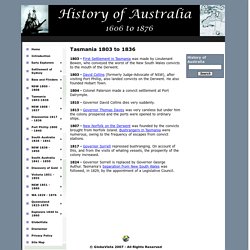
He also founded Hobart Town. 1804 - Colonel Paterson made a convict settlement at Port Dalrymple. 1810 - Governor David Collins dies very suddenly. 1813 - Governor Thomas Davey was very careless but under him the colony prospered and the ports were opened to ordinary ships. 1807 - New Norfolk on the Derwent was founded by the convicts brought from Norfolk Island. 1817 - Governor Sorrell repressed bushranging. 1824 - Governor Sorrell is replaced by Governor George Authur. Van Diemen's Land. Van Diemen's Land 'Up stream Upper Nile Bridge' by John Glover, 1840 (ALMFA, SLT) Tasmania's cultural history was pre-determined for more than a century by its colonial origins and, in particular, by the whole emotive package conjured up by its former name, Van Diemen's Land.
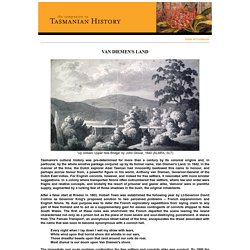
My Place for teachers. The main motivation for the British to settle in Van Diemen's Land between 1803 and 1804 was fear of the French colonising part of the island.
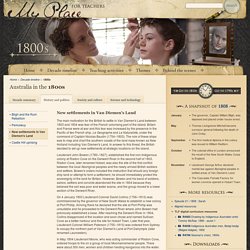
Britain and France were at war and this fear was increased by the presence in the Pacific of two French ship, Le Geographe and Le Naturaliste, under the command of Captain Nicolas Baudin (1754–1803). The role of these ships was to map and chart the southern coasts of the land mass known as New Holland including Van Diemen's Land. In answer to this threat, the British decided to set up new settlements at strategic locations on the island. Lieutenant John Bowen (1780–1827), established the first non-Indigenous colony at Risdon Cove on the Derwent River in the second half of 1803. Risdon Cove, later renamed Hobart, was also the site of the first conflict between the local Aboriginal peoples and the newly arrived British soldiers and settlers.
Documenting Democracy. Order-in-Council separating Van Diemen's Land from New South Wales 14 June 1825 (UK) Significance This document established Van Diemen's Land as a separate Colony independent of New South Wales as provided for in the New South Wales Act 1823, and also authorised the establishment of a separate Legislative Council for Van Diemen's Land.
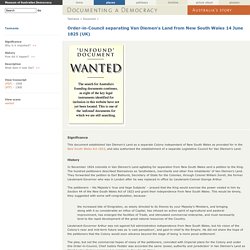
History In November 1824 colonists in Van Diemen's Land agitating for separation from New South Wales sent a petition to the King. Tasmania Time Line Chronological Timetable of Events - Worldatlas.com. Australian history. Island colony, Tasmania, Australia [1642–1855] In Custodia Legis: Law Librarians of Congress. Relics of convict discipline (guns, chains and ball, whip and sword), Hobart, Tasmania, Australia (Beattie, ca. 1900).
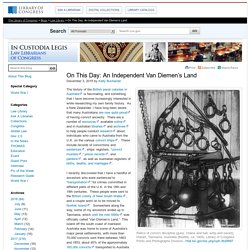
Library of Congress Prints and Photographs Division, //hdl.loc.gov/loc.pnp/cph.3b29597. The history of the British penal colonies in Australia is fascinating, and something that I have become increasingly interested in while researching my own family history. As a New Zealander, I have long been aware that many Australians are now quite proud of having convict ancestry. There are a number of resources available online and in Australian libraries and archives to help people conduct research about individuals who came to Australia from the U.K. on the various convict ships. These include records of convictions and sentences, ships’ registers, “convict musters,” prison records, and pardons, as well as Australian registers of births, deaths, and marriages. Original Governance Arrangements 1823 Act and Charters of Justice Establishment of a Separate Colony by Order in Council.
Impact of European settlement on Aboriginal Tasmanians - History (4,5,9)